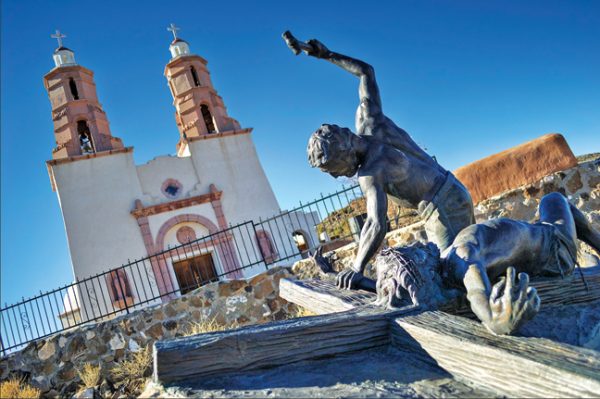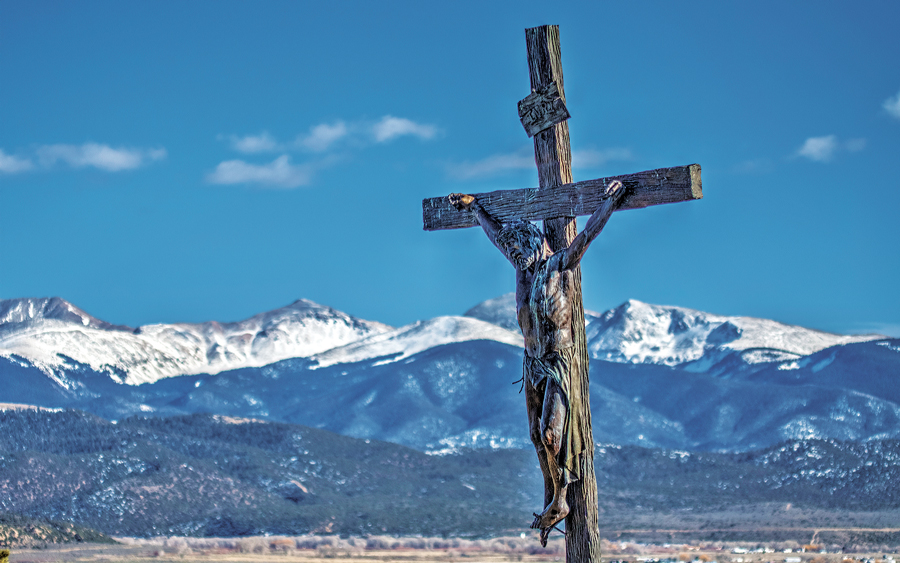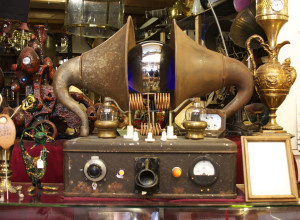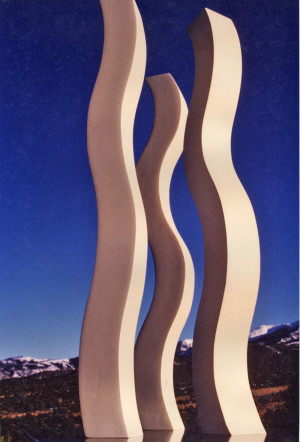Story and photos by John McEvoy
The roots of Hispanic history in Colorado lie beneath the charming little town of San Luis and radiate throughout the San Luis Valley from there.
San Luis is the oldest town in Colorado and is located in one of the world’s highest desert valleys; at over 7,000 feet in elevation, it is bordered by the 14,000-foot peaks of the Sangre de Cristo Mountains to the east and the volcanic San Juan Mountains to the west.

Blanca Peak, one of the sacred mountains of the Dine’, or Navajo Nation, rises to the north of the intersection of Highway 160 and Highway 159, which is 25 miles east of Alamosa.
From there, it is 15 miles south to San Luis along 159, where a large herd of elk may be seen basking in the sun during winter months in one of the empty fields along the way.
The town of San Luis rests at the junction of Colo. Highways 159 and 142 and along the Los Caminos Antiguos (The Ancient Roads) Historic and Scenic Byway.
Evidence of Spanish Colonial influence can be found throughout San Luis, but nowhere as strongly as in the architecture of the chapel on the mesa.
“The Chapel of All Saints” (La Capilla de Todos Los Santos) is a Spanish – Moorish styled adobe church that sits prominently upon the flat top mountain overlooking the town.
Construction of the chapel was finished in 1997. Creation of the Stations of the Cross began in 1988 and was an ongoing project for many years. Both were made possible by donations from parishioners of the Sangre de Cristo Parish.
Primarily a Catholic devotional practice, the Stations of the Cross retrace the final steps made by Jesus Christ on the way to his crucifixion.
Many Stations of the Cross merely consist of pictorial placards hung on the walls of a church and are numbered 1 through 14, starting with the condemnation of Jesus and stopping with the placement of his body in the tomb.
In San Luis, lifelike bronze statues cast at two-thirds life-size greet visitors along the gentle slope of the mile-long path toward the chapel. Each station has a coinciding metal plaque describing the scene taken from the Bible. There are places to rest at each stop.
The devotional trip here ends on a higher note than most, with the resurrection of Jesus included as the 15th station. The last two sculptures showing the crucifixion and resurrection are both life-size depictions of this historic religious event.
The first station, where Jesus is condemned, is strikingly graphic and will prepare visitors for what is to come with the remaining realistic scenes.
The looks of contempt on the judge’s faces and the expression of sad resignation on Jesus’ face as he meekly accepts his fate may make the tour through the stations seem very real for any observer.
Sculptor Huberto Maestas endeavored to capture the emotion of each setting when he designed and created these exquisite pieces of art.
The meticulous details of each scene are stunning. One can see how the vines were woven together into a crown of sharp thorns that gouged into Jesus’ head; the heavy wooden cross upon his bare shoulders embedding splinters into his flesh as he struggled up the hill; the look of horror and helpless anguish on the face of his mother Mary as she met him along the way; the expressions of fear and sorrow on the faces of his followers. All these emotions are made apparent in the fine details on the faces and the body language of each individual work of art.
These dramatic scenes may take one back in time as if personally experiencing the event. One pilgrim along the way commented that they had felt deeply distressed at seeing what brutal savagery this man, the Son of God, had experienced.
As one finishes winding the way up the slope and comes near the end of the trek, the final stations are breathtaking as are the views of the surrounding countryside and the town of San Luis below.
The trail from the depiction of the burial leads around the west side of the chapel and reveals perhaps the most wondrous sculpture of all: Jesus ascending into the blue skies of heaven with a look of rapture upon his face.
The beautiful Chapel of All Saints waits as a place of comfort and refuge, where visitors may quietly reflect about the recent journey.
San Luis native Huberto Maestas began sculpting when he was 10 years old. He has created intricately detailed 3-D works of art that appear all over the world. His Stations of the Cross are perhaps his best known, and there are miniature duplicates of this work in the Vatican. His works of art in bronze range from small tabletop pieces to 30-feet high public monuments and encompasses many diverse styles, including wildlife and images of the Southwest.
In creating these bronze works of art for the Stations of the Cross, Maestas said he tried to envision himself at the scene – to see and hear what it must have been like to be there. Maestas said the only way to depict that in the statues is with the expressions on the faces and the body language of each individual.
John McEvoy writes from under the shadow of cell phone coverage at the base of Lookout Mountain in Del Norte, Colo. and enjoys shooting at anything and everything with his camera.



